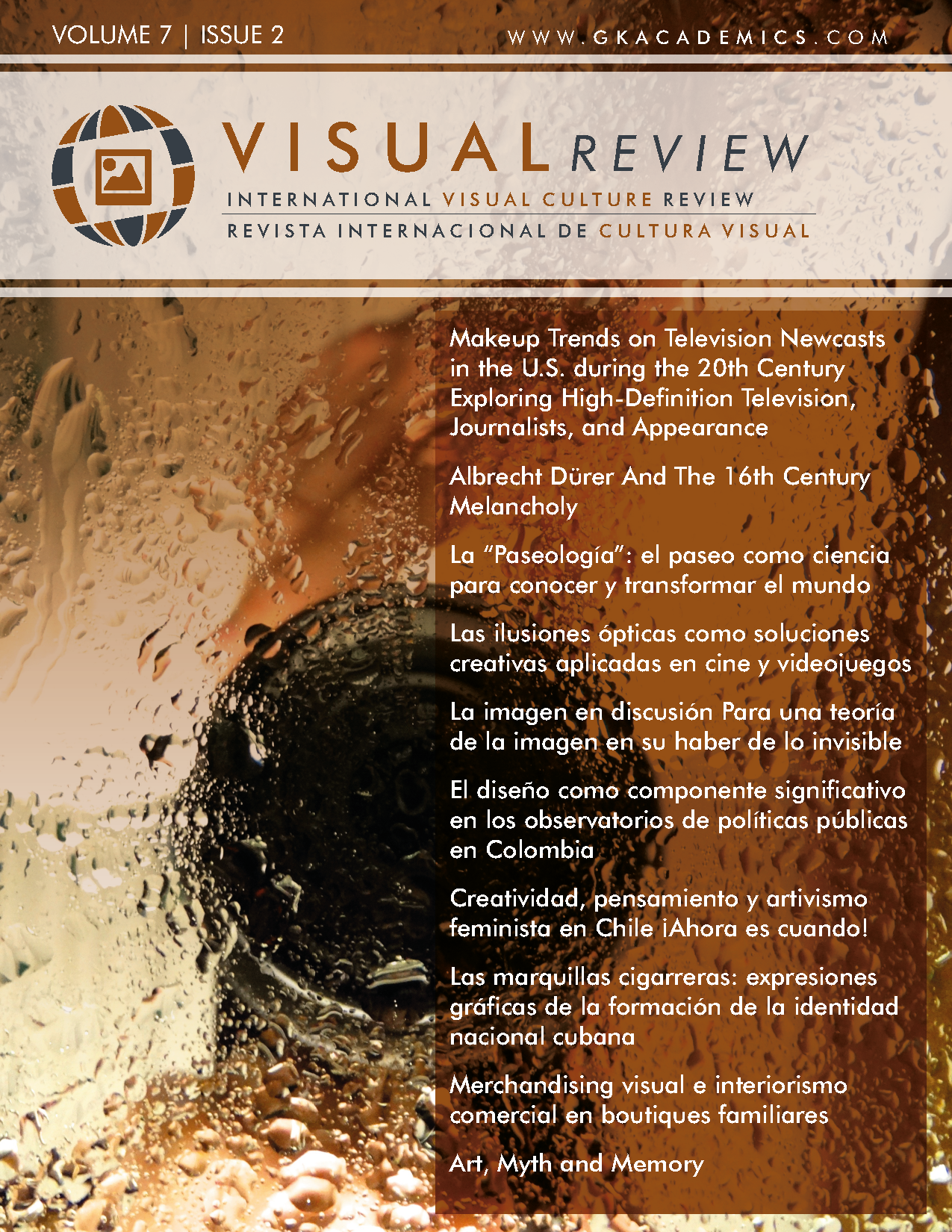Makeup Trends on Television Newcasts in the U.S. during the 20th Century
Exploring High-Definition Television, Journalists, and Appearance
DOI:
https://doi.org/10.37467/gka-revvisual.v7.2694Keywords:
Standard Definition (SDTV), High-definition (HDTV), Female newscasters, Appearance, Makeup, Television, Newscasts, History of communicationAbstract
This study is an exploration of the shift from standard definition (SDTV) to high-definition (HDTV) on television newscasts in the United States. This paper examines how this major historic shift affected the thinking, behavior, and trends of female newscasters when using makeup to see what themes arose. Despite the ubiquity of female newscasters, academic research into the influence of HD broadcasting and makeup appearance is limited. Due to this lack of information, the present study provides a cultural approach to examining historical information about this switch. News West 9 broadcasted in Midland-Odessa and interviews to a female newscaster, a news director, and a makeup artist who experienced this shift are utilized to address the historical issues facing high-definition broadcasting during this time.
Downloads
Global Statistics ℹ️
|
1163
Views
|
461
Downloads
|
|
1624
Total
|
|
References
Baepler, P. The Barbary Captivity Narrative in American Culture. Early American Literature, 39(2), 217-246. DOI: https://doi.org/10.1353/eal.2004.0022
Berkenstein, J., Froula, A. and Randell, K. (eds.) (2010). Reframing 9/11: Film, Popular Culture and the “War on Terror.” New York: Continuum. DOI: https://doi.org/10.5040/9781628928280
Bouchard, G. (2017). Social Myths and Collective Imaginaries. Toronto: University of Toronto Press. DOI: https://doi.org/10.3138/9781442625730
Briefel, A. and Miller, S. J. (eds.) (2011). Horror After 9/11. Austin: University of Texas Press. DOI: https://doi.org/10.7560/726628
Castiglia, C. (1996). Bound and Determined: Captivity, Culture-Crossing, and White Womanhood from Mary Rowlandson to Patty Hearst. Chicago: University of Chicago Press.
Cobb, W. C. (1998). The American Foundation Myth in Vietnam: Reigning Paradigms and Raining Bombs. Lanham, MD: University Press of America.
Comaroff, J. and Comaroff, J. L. (2002). Alien-Nation: Zombies, Immigrants, and Millennial Capitalism. The South Atlantic Quarterly, 101 (4) 779-805. DOI: https://doi.org/10.1215/00382876-101-4-779
Cox, D. and Levine, M. (2016). ‘I am not living next door to no zombie’: Posthumans and Prejudice. Critical Philosophy of Race, 4(1), 74-94. DOI: https://doi.org/10.5325/critphilrace.4.1.0074
Drezner, D. W. (2011). Theories of International Politics and Zombies. Princeton: Princeton University Press.
Entman, R. M. and Rojecki, A. (2001). The Black Image in the White Mind. Chicago: University of Chicago Press. DOI: https://doi.org/10.7208/chicago/9780226210773.001.0001
Grandin, G. (2007). Empire's Workshop: Latin America, the United States, and the Rise of the New Imperialism. New York: Holt.
Limerick Patricia, N. (1995). Turnerians All: The Dream of a Helpful History in an Intelligible World. The American Historical Review, 100(3), 697-716. DOI: https://doi.org/10.2307/2168601
Luckhurst, R. (2015). Zombies, A Cultural History. London: Reaktion Books.
MacNeil, D. (August 15, 2006). “Mary Rowlandson and the Foundational Mythology of the American Frontier Hero.” Women’s Studies, 625-653. DOI: https://doi.org/10.1080/00497870500359522
McCain, J. S. (2008). John McCain, Prisoner of War: A First-Person Account. US News and World Report, January 28.
McIntosh, S. and Leverette, M. (eds.) (2012). Zombie Culture, Autopsies of the Living Dead. Lanham, MD: Scarecrow Press.
Mitchell, N. (2000). The Danger of Dream: German and American Imperialism in Latin America. Chapel Hill: University of North Carolina Press.
Rhodes, G. D. (2001). White Zombie, Anatomy of a Horror Film Jefferson. NC: McFarland.
Schmidt, H. (1995). The United States Occupation of Haiti, 1915-1934. New Brunswick, NJ: Rutgers University Press.
Schoultz, L. (1998). Beneath the United States: A History of U.S. Policy Toward Latin America. Cambridge: Harvard. DOI: https://doi.org/10.4159/9780674043282
Seabrook, W. ([1929] 2016). The Magic Island. New York: Dover Books.
Slotkin, R. (1973). Regeneration Through Violence, The Mythology of the American Frontier, 1600-1860. Norman: University of Oklahoma Press.
Sutherland, M. (Spring, 2007) Rigor/Mortis: The Industrial Life of Style in American Zombie Cinema. Framework, 48(1), 64-78. DOI: https://doi.org/10.1353/frm.2007.0008
Tirman, J. (2011). The Deaths of Others: The Fate of Civilians in America’s Wars. New York: Oxford University Press. DOI: https://doi.org/10.1093/acprof:osobl/9780195381214.001.0001
Wegener, S. E. (2005). James Fenimore Cooper Versus the Cult of Domesticity: Progressive Themes of Femininity and Family in the Novels. Jefferson, NC: McFarland.
Wetmore, K. J. (2012). Post-9/11 Horror in American Cinema. New York: Continuum. DOI: https://doi.org/10.5040/9781628928884
Williams, T. (1983). White Zombie, Haitian Horror. Jump Cut, 28, 18-20.
Downloads
Published
How to Cite
Issue
Section
License
Those authors who publish in this journal accept the following terms:
-
Authors retain copyright.
-
Authors transfer to the journal the right of first publication. The journal also owns the publishing rights.
-
All published contents are governed by an Attribution-NoDerivatives 4.0 International License.
Access the informative version and legal text of the license. By virtue of this, third parties are allowed to use what is published as long as they mention the authorship of the work and the first publication in this journal. If you transform the material, you may not distribute the modified work. -
Authors may make other independent and additional contractual arrangements for non-exclusive distribution of the version of the article published in this journal (e.g., inclusion in an institutional repository or publication in a book) as long as they clearly indicate that the work was first published in this journal.
- Authors are allowed and recommended to publish their work on the Internet (for example on institutional and personal websites), following the publication of, and referencing the journal, as this could lead to constructive exchanges and a more extensive and quick circulation of published works (see The Effect of Open Access).













